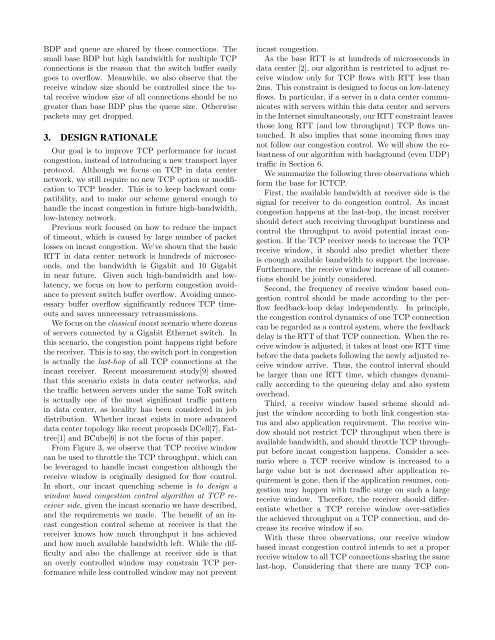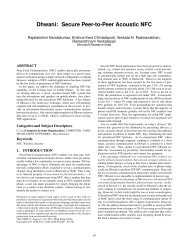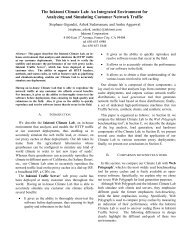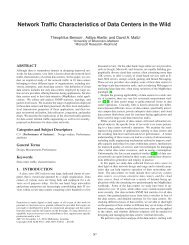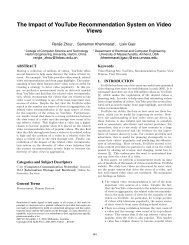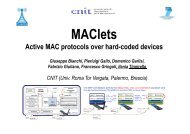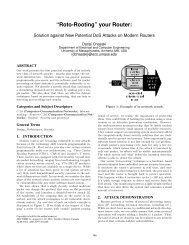ICTCP: Incast Congestion Control for TCP in Data Center ... - Sigcomm
ICTCP: Incast Congestion Control for TCP in Data Center ... - Sigcomm
ICTCP: Incast Congestion Control for TCP in Data Center ... - Sigcomm
You also want an ePaper? Increase the reach of your titles
YUMPU automatically turns print PDFs into web optimized ePapers that Google loves.
BDP and queue are shared by those connections. The<br />
small base BDP but high bandwidth <strong>for</strong> multiple <strong>TCP</strong><br />
connections is the reason that the switch buffer easily<br />
goes to overflow. Meanwhile, we also observe that the<br />
receive w<strong>in</strong>dow size should be controlled s<strong>in</strong>ce the total<br />
receive w<strong>in</strong>dow size of all connections should be no<br />
greater than base BDP plus the queue size. Otherwise<br />
packets may get dropped.<br />
3. DESIGN RATIONALE<br />
Our goal is to improve <strong>TCP</strong> per<strong>for</strong>mance <strong>for</strong> <strong>in</strong>cast<br />
congestion, <strong>in</strong>stead of <strong>in</strong>troduc<strong>in</strong>g a new transport layer<br />
protocol. Although we focus on <strong>TCP</strong> <strong>in</strong> data center<br />
network, we still require no new <strong>TCP</strong> option or modification<br />
to <strong>TCP</strong> header. This is to keep backward compatibility,<br />
and to make our scheme general enough to<br />
handle the <strong>in</strong>cast congestion <strong>in</strong> future high-bandwidth,<br />
low-latency network.<br />
Previous work focused on how to reduce the impact<br />
of timeout, which is caused by large number of packet<br />
losses on <strong>in</strong>cast congestion. We’ve shown that the basic<br />
RTT <strong>in</strong> data center network is hundreds of microseconds,<br />
and the bandwidth is Gigabit and 10 Gigabit<br />
<strong>in</strong> near future. Given such high-bandwidth and lowlatency,<br />
we focus on how to per<strong>for</strong>m congestion avoidance<br />
to prevent switch buffer overflow. Avoid<strong>in</strong>g unnecessary<br />
buffer overflow significantly reduces <strong>TCP</strong> timeouts<br />
and saves unnecessary retransmissions.<br />
We focus on the classical <strong>in</strong>cast scenario where dozens<br />
of servers connected by a Gigabit Ethernet switch. In<br />
this scenario, the congestion po<strong>in</strong>t happens right be<strong>for</strong>e<br />
the receiver. This is to say, the switch port <strong>in</strong> congestion<br />
is actually the last-hop of all <strong>TCP</strong> connections at the<br />
<strong>in</strong>cast receiver. Recent measurement study[9] showed<br />
that this scenario exists <strong>in</strong> data center networks, and<br />
the traffic between servers under the same ToR switch<br />
is actually one of the most significant traffic pattern<br />
<strong>in</strong> data center, as locality has been considered <strong>in</strong> job<br />
distribution. Whether <strong>in</strong>cast exists <strong>in</strong> more advanced<br />
data center topology like recent proposals DCell[7], Fattree[1]<br />
and BCube[6] is not the focus of this paper.<br />
From Figure 3, we observe that <strong>TCP</strong> receive w<strong>in</strong>dow<br />
can be used to throttle the <strong>TCP</strong> throughput, which can<br />
be leveraged to handle <strong>in</strong>cast congestion although the<br />
receive w<strong>in</strong>dow is orig<strong>in</strong>ally designed <strong>for</strong> flow control.<br />
In short, our <strong>in</strong>cast quench<strong>in</strong>g scheme is to design a<br />
w<strong>in</strong>dow based congestion control algorithm at <strong>TCP</strong> receiver<br />
side, given the <strong>in</strong>cast scenario we have described,<br />
and the requirements we made. The benefit of an <strong>in</strong>cast<br />
congestion control scheme at receiver is that the<br />
receiver knows how much throughput it has achieved<br />
and how much available bandwidth left. While the difficulty<br />
and also the challenge at receiver side is that<br />
an overly controlled w<strong>in</strong>dow may constra<strong>in</strong> <strong>TCP</strong> per<strong>for</strong>mance<br />
while less controlled w<strong>in</strong>dow may not prevent<br />
<strong>in</strong>cast congestion.<br />
As the base RTT is at hundreds of microseconds <strong>in</strong><br />
data center [2], our algorithm is restricted to adjust receive<br />
w<strong>in</strong>dow only <strong>for</strong> <strong>TCP</strong> flows with RTT less than<br />
2ms. This constra<strong>in</strong>t is designed to focus on low-latency<br />
flows. In particular, if a server <strong>in</strong> a data center communicates<br />
with servers with<strong>in</strong> this data center and servers<br />
<strong>in</strong> the Internet simultaneously, our RTT constra<strong>in</strong>t leaves<br />
those long RTT (and low throughput) <strong>TCP</strong> flows untouched.<br />
It also implies that some <strong>in</strong>com<strong>in</strong>g flows may<br />
not follow our congestion control. We will show the robustness<br />
of our algorithm with background (even UDP)<br />
traffic <strong>in</strong> Section 6.<br />
We summarize the follow<strong>in</strong>g three observations which<br />
<strong>for</strong>m the base <strong>for</strong> <strong>IC<strong>TCP</strong></strong>.<br />
First, the available bandwidth at receiver side is the<br />
signal <strong>for</strong> receiver to do congestion control. As <strong>in</strong>cast<br />
congestion happens at the last-hop, the <strong>in</strong>cast receiver<br />
should detect such receiv<strong>in</strong>g throughput burst<strong>in</strong>ess and<br />
control the throughput to avoid potential <strong>in</strong>cast congestion.<br />
If the <strong>TCP</strong> receiver needs to <strong>in</strong>crease the <strong>TCP</strong><br />
receive w<strong>in</strong>dow, it should also predict whether there<br />
is enough available bandwidth to support the <strong>in</strong>crease.<br />
Furthermore, the receive w<strong>in</strong>dow <strong>in</strong>crease of all connections<br />
should be jo<strong>in</strong>tly considered.<br />
Second, the frequency of receive w<strong>in</strong>dow based congestion<br />
control should be made accord<strong>in</strong>g to the perflow<br />
feedback-loop delay <strong>in</strong>dependently. In pr<strong>in</strong>ciple,<br />
the congestion control dynamics of one <strong>TCP</strong> connection<br />
can be regarded as a control system, where the feedback<br />
delay is the RTT of that <strong>TCP</strong> connection. When the receive<br />
w<strong>in</strong>dow is adjusted, it takes at least one RTT time<br />
be<strong>for</strong>e the data packets follow<strong>in</strong>g the newly adjusted receive<br />
w<strong>in</strong>dow arrive. Thus, the control <strong>in</strong>terval should<br />
be larger than one RTT time, which changes dynamically<br />
accord<strong>in</strong>g to the queue<strong>in</strong>g delay and also system<br />
overhead.<br />
Third, a receive w<strong>in</strong>dow based scheme should adjust<br />
the w<strong>in</strong>dow accord<strong>in</strong>g to both l<strong>in</strong>k congestion status<br />
and also application requirement. The receive w<strong>in</strong>dow<br />
should not restrict <strong>TCP</strong> throughput when there is<br />
available bandwidth, and should throttle <strong>TCP</strong> throughput<br />
be<strong>for</strong>e <strong>in</strong>cast congestion happens. Consider a scenario<br />
where a <strong>TCP</strong> receive w<strong>in</strong>dow is <strong>in</strong>creased to a<br />
large value but is not decreased after application requirement<br />
is gone, then if the application resumes, congestion<br />
may happen with traffic surge on such a large<br />
receive w<strong>in</strong>dow. There<strong>for</strong>e, the receiver should differentiate<br />
whether a <strong>TCP</strong> receive w<strong>in</strong>dow over-satisfies<br />
the achieved throughput on a <strong>TCP</strong> connection, and decrease<br />
its receive w<strong>in</strong>dow if so.<br />
With these three observations, our receive w<strong>in</strong>dow<br />
based <strong>in</strong>cast congestion control <strong>in</strong>tends to set a proper<br />
receive w<strong>in</strong>dow to all <strong>TCP</strong> connections shar<strong>in</strong>g the same<br />
last-hop. Consider<strong>in</strong>g that there are many <strong>TCP</strong> con-


